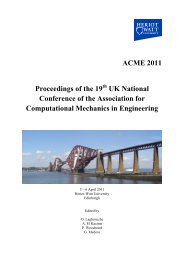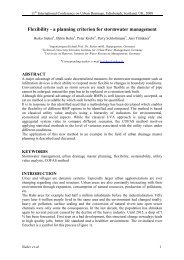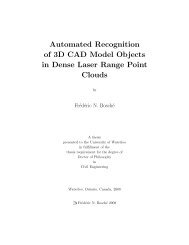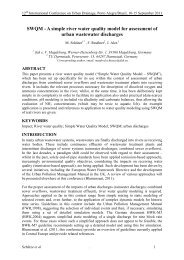Emissions of pollutant loads from combined sewer systems and ...
Emissions of pollutant loads from combined sewer systems and ...
Emissions of pollutant loads from combined sewer systems and ...
Create successful ePaper yourself
Turn your PDF publications into a flip-book with our unique Google optimized e-Paper software.
140000<br />
120000<br />
100000<br />
80000<br />
60000<br />
40000<br />
20000<br />
11 th International Conference on Urban Drainage, Edinburgh, Scotl<strong>and</strong>, UK, 2008<br />
0<br />
WWTP dw<br />
WWTP ww<br />
CSO or SSO<br />
Cu CSS Cu SSS carb CSS carb SSS E2 CSS E2 SSS<br />
Figure 3. Emitted <strong>loads</strong> <strong>of</strong> copper (Cu) [g/year], carbamazepine (carb) [mg/10/year] <strong>and</strong><br />
estradiol (E2) [mg*10/year] calculated by pollution load simulations<br />
WWTP (dw): effluent WWTP dry weather; WWTP (ww): effluent WWTP wet weather; CSO: <strong>combined</strong> <strong>sewer</strong> overflow; SSO: storm <strong>sewer</strong> outlets; CSS:<br />
<strong>combined</strong> <strong>sewer</strong> system; SSS: separate <strong>sewer</strong> system<br />
Disconnection <strong>of</strong> paved areas<br />
A common measure to reduce emissions <strong>from</strong> urban drainage <strong>systems</strong> is the disconnection <strong>of</strong><br />
paved areas <strong>from</strong> the drainage system. This is especially true for low contaminated flow types<br />
like ro<strong>of</strong> run<strong>of</strong>f <strong>and</strong> run<strong>of</strong>fs <strong>from</strong> street areas with a low traffic density. These flow types are<br />
<strong>of</strong>ten infiltrated to the groundwater by several devices (e.g. trenches).<br />
Exclusively by the example <strong>of</strong> the chosen hypothetical separate <strong>sewer</strong> system 25 % <strong>of</strong> the<br />
paved areas were disconnected, demonstrated in Figure 4 for the surface run<strong>of</strong>f derived<br />
parameters COD <strong>and</strong> copper. This value certainly represents an upper limit in existing<br />
<strong>systems</strong>. Within, the annual pollution <strong>loads</strong> infiltrated into the soil groundwater system are<br />
illustrated as white bars.<br />
Results for COD <strong>and</strong> copper clearly show, that even a significant disconnection <strong>of</strong> paved<br />
areas leads to dominant total emissions resulted <strong>from</strong> the separate <strong>sewer</strong> system. Therefore,<br />
also under these conditions, total emissions to the receiving waters <strong>from</strong> the <strong>combined</strong> <strong>sewer</strong><br />
system are significant lower in relation to a separate <strong>sewer</strong> system.<br />
6 Welker













